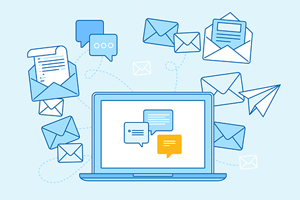
The first question asked when discussing electronic data exchanges is “How much will it cost?”
A better question might be: “How much will it save?”
“Of course, there are costs involved in converting to an electronic solution, but the benefits of EDX outweigh them,” write the authors of AACRAO’s Basic Guide to Electronic Data Exchange, updated and published this summer.
Most institutions don’t have an accurate assessment of the unit cost of sending and receiving a paper transcript. A comparison is articulated below.
Paper-based transcript cost considerations include:
When sending
-
security paper and school seals,
-
printer and toner,
-
envelopes and postage
-
labor for sorting, matching the pages of documents, stuffing envelopes, and printing and affixing mailing labels,
-
cost of outsourcing these functions, if applicable.
When receiving
-
manually processing mail,
-
matching documents to applicant or enrollee records,
-
sorting, batching and/or filing,
-
transcript data entry and associated corrections,
-
manual evaluation decisions,
-
GPA calculations,
-
confirming prerequisites have been satisfied, and
-
filing or scanning,
-
storing paper documents or housing them at a secure facility
EDX transcript cost considerations include:
-
accessing electronic data,
-
purchasing hardware and software,
-
technical expertise for programming, networking, data integration, and software development,
-
one-time costs of hiring talent or a service provider for technical and functional expertise mapping the transcript data in the SIS to the electronic transcript specifications for EDI or XML, and
-
training staff in new business processes
-
maintaining trading partner relationships, service provider contracts, and continued efforts toward automation or integration.
“Due to differences in labor costs and the number of employees, the cost and value of electronic transcripts will vary from institution to institution,” the authors write. “In general, institutions may experience 25 to 35 percent savings by switching from the sending of paper to electronic transcripts.”
The Guide also covers EDX standards, PDF transcripts, processing system requirements, and much more.
Related Content
Basic Guide to Electronic Data Exchange
The
Basic Guide to Electronic Data Exchange compiles education record electronic data exchange (EDX)-related technology tips and resources in one place to help AACRAO members and their institutions understand, analyze, and implement EDX of education records. Institutions that provide electronic transcripts and electronic transcript services throughout various phases of the student lifecycle will improve student satisfaction and benefit from increased efficiency in their operations. Originally published in 2008, this version of the Basic Guide to EDX has been written and updated by past and present AACRAO SPEEDE Committee members to address the most commonly asked questions regarding electronic data exchanges.